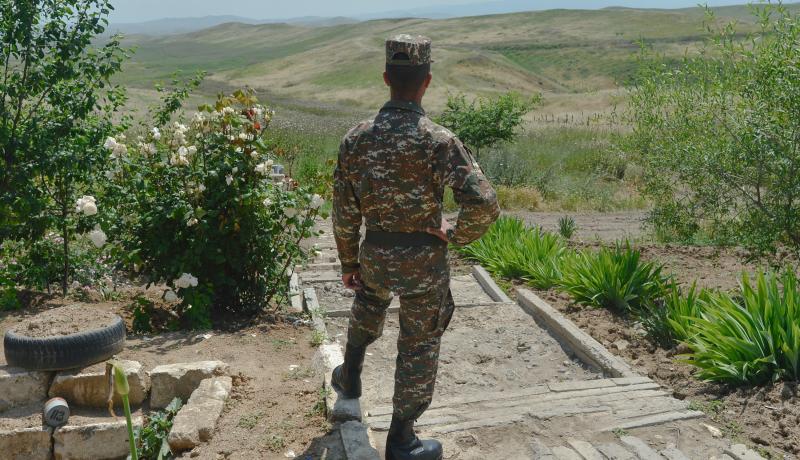
Time to honour commitments to Armenian-Azerbaijani peace

One year on from a major outbreak of violence, the Armenian-Azerbaijani peace process is again in peril. The international community can either hang back and wait for war, or opt for diplomatic shock therapy.
The last year has demonstrated the resilience of Armenian-Azerbaijani deadlock in resisting movement in the direction of either war or peace. On 2 April it will be one year since a major escalation, widely referred to as the four-day ‘war’, that claimed more than 200 lives. Yet while pundits warned plausibly of contagion, the violence quickly subsided as Moscow brokered a ceasefire.
A few weeks later at talks in Vienna brokered by the Minsk Group of the Organization for Security and Cooperation (OSCE), President Serzh Sargsyan of Armenia and President Ilham Aliyev of Azerbaijan gave their formal assent to long called for confidence building measures. These included an expanded ceasefire monitoring mission and an incident investigation mechanism. They also committed to moving to comprehensive negotiations. Catering to respective Armenian and Azerbaijani priorities, these formal agreements appeared to set the stage for progress.
One year later the situation resembles that of exactly one year ago. No substantive progress has been achieved on the commitments made in Vienna, it is business as usual with violent incidents resuming along the Line of Contact (LoC), and the peace process is suspended in a perilous void.
Key differences
But there are three main ways in which today’s situation differs from one year ago.
First, today’s situation is more dangerous than it was a year ago. If we accept, which most analysts do, that Azerbaijan was behind last April’s escalation, Baku now risks demonstrating that what it sees as its primary source of leverage over the peace process is ineffective. This learning curve coincides with heightened domestic expectations around Azerbaijan’s ability to effectively use its newly acquired weaponry to regain territory.
Second, fluidity in the regional politics surrounding the Armenian-Azerbaijani conflict has seen it increasingly wedged in behind other regional (in-)security complexes. Russia’s power play in Syria, the anticipated dissolution of ISIS and possible consequences for the North Caucasus consolidation in Crimea and continuing conflict in Donbas are reshaping the South Caucasus as a strategic bedrock behind the frontlines of Russian power projection elsewhere. The Armenian-Azerbaijani conflict is becoming ever more embedded within a Russian-dominated space in ways that simultaneously militarize and de-prioritize the conflict in the light of other first-order imperatives.
Yet while Russia appears to be the consistent tactical beneficiary of its engagements in the wider area, profligate militarization of Armenia and Azerbaijan is eroding its local political standing. This is evident not only in rising ‘Eurasia-scepticism’ in Armenia, but in the apparent sidelining of Russia’s recent mediation initiative led by Foreign Minister Sergey Lavrov. Reformulating rather than replacing the OSCE Minsk Group’s proposals, whatever incentives offered by the ‘Lavrov Plan’ have been outstripped by the grandstanding permitted by Russian arms deliveries. In September what are thought to be newly acquired, long-range Iskander-M missiles were displayed on the streets of the Armenian capital. Azerbaijan responded with the reported purchase of Israel’s Iron Dome missile defence system in December.
A third significant development is the acceleration of regime consolidation strategies across the conflict. To be sure, these are long-term. But April’s escalation effectively consolidated regime support bases and weakened their opponents. Armenia’s dubious transition to a parliamentary system is being preceded by a campaign for elections on 2 April already scarred by violence. In September 2016 Azerbaijan rushed through a constitutional referendum prolonging already unlimited presidential terms, making elections an ever more occasional and symbolic concession to democratic norms. In the unrecognized Nagorno-Karabakh Republic, the secessionist entity at the heart of the conflict, a new constitution has likewise removed presidential term limits.
These hurried consolidations of power curtail the capacity of already superficial reforms to temper the socio-economic frustrations of many ordinary Armenians and Azerbaijanis. They deepen the vulnerability of Armenian and Azerbaijani states to external shocks, and in turn, to scenarios where military alternatives to dealing with domestic problems can become attractive.
Articulating a peace strategy
Strategies of conflict are clearly visible across the divide. Deafeningly absent is a strategy of peace. The agreements reached in Vienna in May 2016 show that when international attention is focused and coordinated, the parties can cooperate. Had those pledges been implemented the dynamic on the ground would be different today. But the rapid relapse in international attention, combined with domestic pressures of the national leaderships’ own making, has led to a familiar collective default by belligerents and mediators alike.
One way to revitalize the Minsk Process would be to hold the Minsk Conference. Mandated by the OSCE Council of Ministers on 24 March 1992 to promote a peaceful resolution of the Armenian-Azerbaijani conflict, this conference has never actually convened. Possible rebuttals to this idea are many: a new Minsk Conference would be no more than a talking shop, regional and global power backing is absent, the parties are not ready, appetite is lacking. The mantra of reinvigorating the Minsk Process is met with weary lip-service, but no more than that.
All of these arguments have held for many years already, and constitute part of the perceptual and political lethargy enabling and embedding the escalatory dynamic across the conflict today. Unless the OSCE is ready to see and manage a second major international conflict in its area, a significant international effort is urgently required to envision and articulate a peace strategy as an alternative. This must include serious evidence of international commitments to post-settlement security: who will do what to secure the post-settlement future. This is indispensable for the de-securitization of vital issues of displaced community return and territorial status determination. It would also require a complex mediation structure capable of addressing multiple issues simultaneously, a capacity precluded by today’s negotiating format.
Significant momentum would be needed to focus the necessary international attention and resources on a conflict with which all have become comfortable. That momentum could come from a major new war. Or it could come from a major new multilateral initiative, preventing rather than rewarding violence.
Laurence Broers




















